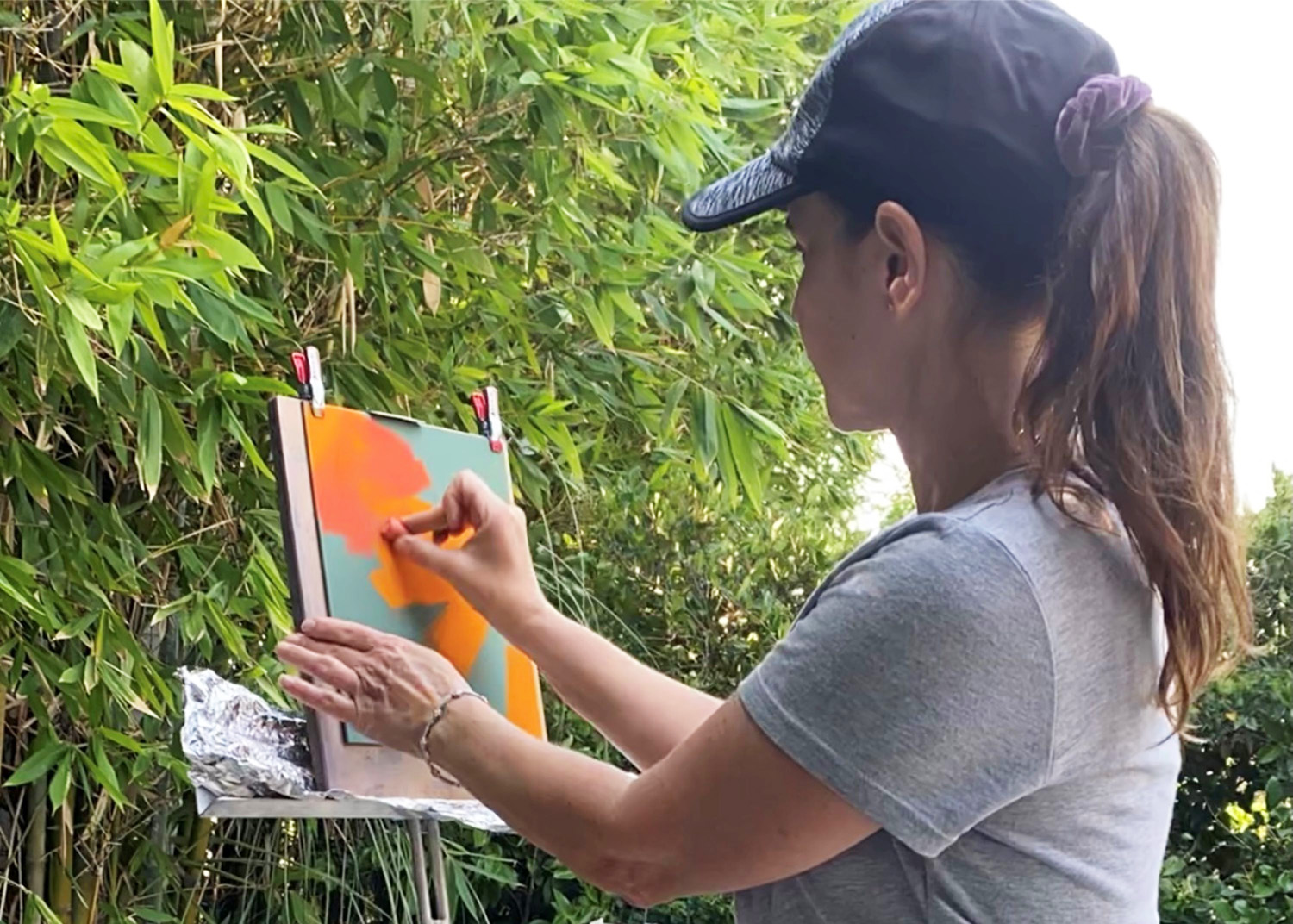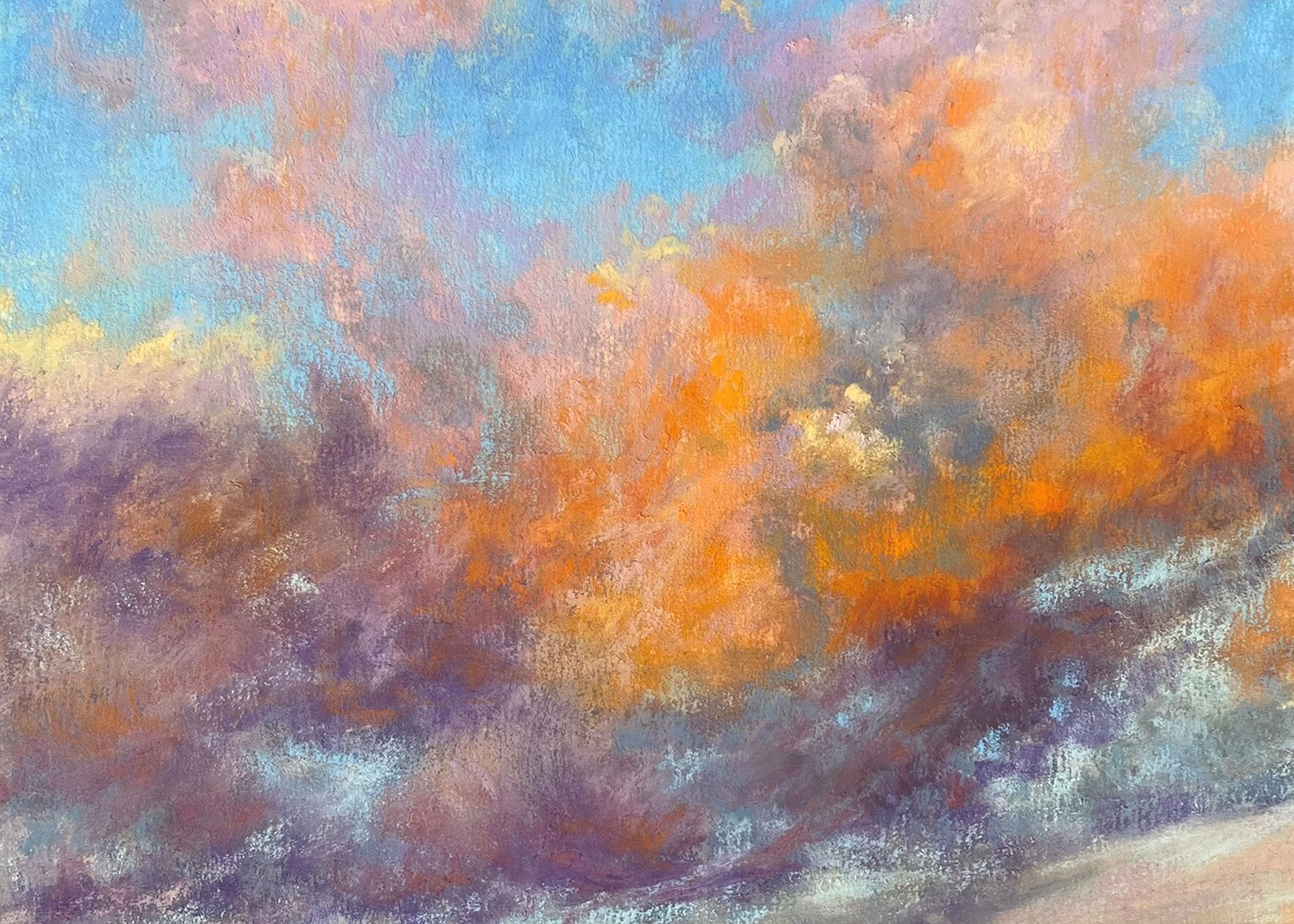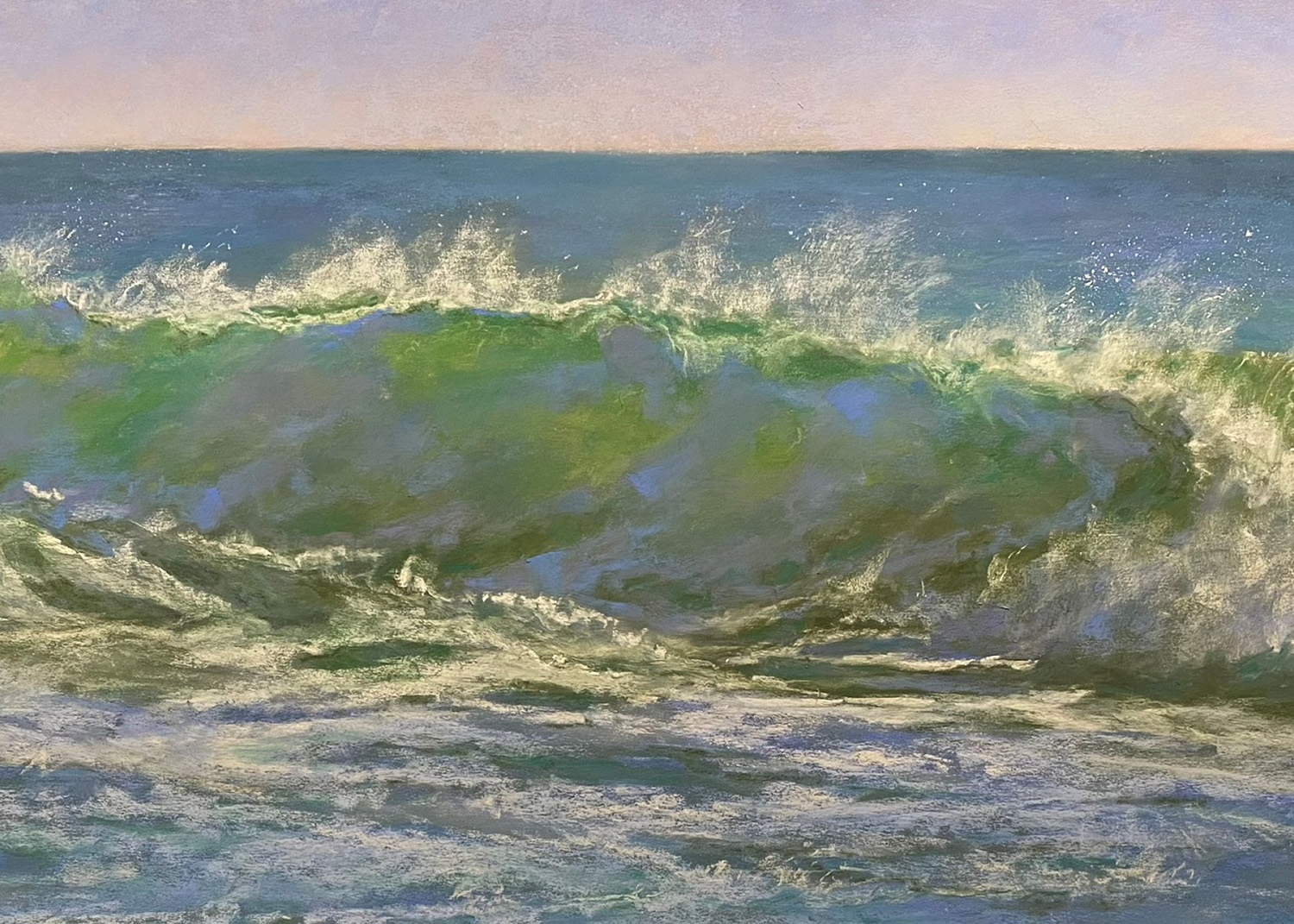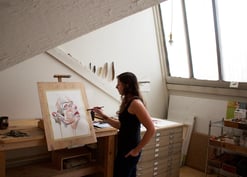Dina Gardner's journey to becoming a professional artist was an unconventional one, starting in her mid-50s after a successful career in entrepreneurship.
Her passion for pastel painting, influenced by nature and driven by meticulous planning and structured routines, led her to retire from her corporate career, achieving success with a unique artistic style that captures the essence of her surroundings.
Can you tell us about your process?
I’m very process oriented so it’s a little bit like Groundhog Day in my studio: a rinse and repeat of the day before. I find that having a simple process that I can repeat each day works best for me.
My day always starts with my music selection. Music sets the stage for my work and influences my paintings in a myriad of ways. Lyrics or song titles often end up as titles for my paintings. If I’m painting an abstract, I usually scribble lyrics on my canvas at the very beginning of a painting. Sometimes they are visible on my finished work and other times they get covered up as I add additional layers. I find I’m most successful when I plan ahead and know what I’m going to work on before I get to my studio. While I don’t pre-select my pastels ahead of time, I do select my photo reference. I do this before my morning walks or bike rides and during these, I’m really in my head, mentally working out the composition and challenges I think I’ll encounter when I put pastel to paper.
While I step back from my easel often, I also have a wonderful hanging chair that I sit in every couple of hours so I can study what I’m painting. I take photos of a painting in process. Viewing my painting on my phone is the best way for me to figure out what’s working and what needs to be adjusted. When I leave my studio at the end of the day, I either leave a painting on the easel that still needs work or I’ll start a painting with some basic information so that I walk into the beginning of a new painting the next day. I’m more focused and excited to get to my studio when I have a painting waiting for me on my easel. I like to come into my studio and be able to jump right back in where I left off.
Can you tell us about your journey to becoming a professional artist?
I’ve had a pretty unconventional start as an artist. I didn’t attend art school and I wasn’t particularly intrigued by art when I was growing up. I wasn’t that kid who loved going to art museums and I certainly never engaged in art in any real meaningful way. At most, I liked arts and crafts but I never had any intention of creating art. In fact, I was really late to the party, taking my first art class in my mid-50s.
I have always been very entrepreneurial. When I was 25, I founded my first company, a recruiting firm in Boston. I went on to start and manage two more recruiting firms and while, from a left brain/right brain perspective, I think recruiting and art could not be further away from each on the creative spectrum, I can see, in hindsight, that I have been able to transfer many of the skills I learned as an entrepreneur/business owner/headhunter to my life as an artist.
In 2016 I reluctantly took a pastel workshop and to my surprise, I got bit hard by the pastel bug. When I say hard, I mean I was all in. I immediately set up a daily painting practice and for the next year, I was at my easel by 5:00 am every morning painting for an hour before heading to my office to my ‘real job.’ I started taking classes, attending workshops and pastel conventions and reading everything I could about pastels.
After a few years of immersing myself in all things pastel, I completely lost interest in my day job. I retired from ‘the grind’ in 2018 and I’ve never regretted it for even a second. 
When you are looking for inspiration, what resources do you turn to?
I have thousands of photo references that I’ve taken over the years and that I’ve got pretty well organized by subject matter. These always inspire me. I’ll also review my older work to spark ideas.
One of my favorite things to do is to take an older painting and look at it with fresh eyes. I love to make changes based on all that I have learned since I first painted it. It gives me a confidence boost too when I’m feeling stuck. Additionally, I am always writing down potential painting titles and I’ve got hundreds of them. It might be a phrase I’ve heard or read or a lyric that I’m drawn to.
Often, when I’m needing inspiration, I’ll randomly pick something from the list and then paint a piece that I feel fits that title. Right now I actually have a painting on my easel titled “Clouds in A Minor” which was originally inspired by a live version I heard of Elton John’s “Border Song.” It is shaping up to be a very moody, restless piece that completely embraces the title.
And, lastly, I’m always inspired by my travels, whether they’re local or on the other side of the world. Traveling really gets my artistic juices flowing and gets me anxious to get back to my studio to paint.
Walk us through a typical day in your studio. What is your routine?
As always, there’s the music. I turn that on and then pull the preselected photo reference up on my phone and sketch the big shapes on my canvas. I’ll pull a few boxes of pastels over to the easel and then I just kind of go forth and conquer.
A typical day includes quite a bit of singing, mostly off key. When I can’t find the right pastel from the boxes I’ve pulled, I’ll bust a few moves across the studio floor as I search for the right one. So there is quite a bit of dancing and singing that happens. If I’m working in a series, I like to work on multiple canvases at the same time. I keep an extremely organized and clutter- free home but in my studio, not so much. There are pastels everywhere!

Finding the right rhythm to be productive in the studio can be a challenge, what advice do you have for staying productive and focused?
For me it’s having goals before I get to the studio. Knowing what I want to paint and working out the challenges I might encounter before I get there keeps me focused. Working toward something…a show, a project of some sort, experimenting with new techniques or subject matter…keeps me productive. When I go to my studio without a plan I tend to putter around and get very little accomplished. My years as a headhunter really taught me that I do my best work when I’ve got a plan, goals and focus.
What is your advice for combating creative block?
It certainly happens. When I hit that wall, I go back to what I know best which are waves, skies and marshes. Revisiting subjects I’m familiar with helps me combat creative blocks. I’ll also look at tons of reference materials…photos, art magazines, notes I’ve taken in workshops, older pieces of my work. These are a few tried and true ways to help me get my creative juices flowing.

As an artist, how do you measure your success? Can you recall a specific event or milestone(s) in your career that made you feel successful?
Let me start by saying that I’ve painted many hundreds of really bad paintings and each bad painting has taught me something. Even little successes in bad paintings give me confidence - which lead to future successes.
My greatest success to date was being awarded Full Member status via Jury Selection at the prestigious Copley Society of Art on Newbury Street in Boston. I’ve walked by the gallery for over 30 years and I never dreamed I would actually have paintings hanging on those gallery walls!
Another highlight for me was being offered an artist residency at the Art Association of Nantucket. And, when they asked me to teach classes there, that was another highlight for me. My other successful moment was a show I was invited to participate in at Maine Art Hill in Kennebunkport, Maine. I sold 23 paintings which was a really incredible and rewarding experience.
How do you see the art market changing? Where do you see yourself in this transition?
I think social media has really changed the landscape for the artists and buyers. I’m seeing fewer brick and mortar galleries and I know that for me, most of my work is selling through online channels these days.
I like to gallery hop, so I would love to see galleries thriving, but I think the online ‘gallery’ world allows artists and consumers to get the opportunity to be exposed to an incredible range and amount of artwork that isn’t possible in the traditional retail environment.

What advice do you have for artists who are beginning to build their careers?
I think the key to success with any endeavor is putting in your 10,000 hours. My ‘year of daily practice’ when I first found painting put me on a trajectory I couldn’t have realized without that kind of focus and dedication.
I also think it’s important to paint what you love, not what will sell. I once had a teacher tell me moody paintings with overcast skies never sell but I enjoy painting them and I’ve sold plenty of those. If you create work that speaks to you, you’ll find people that share your vision.
Art is such a personal choice and I’ve learned that painting what moves me, not what I think will sell, makes for a happy day in my studio. Having an online presence with a robust website as well as the exposure I’ve gained through Turning Art has definitely created more opportunities for my work to get exposure.
Do you consider yourself, and all artists, to be entrepreneurs? Why or why not?
Definitely. As artists we create. As entrepreneurs, we create. Personally, as someone with a long history of entrepreneurship, I’ve always been most excited about building something vs maintaining or running the day- to- day.
The creative part is in the building, whether it’s building a business or in the stages of building a painting. As a business entrepreneur, my strengths like having goals and a plan, organizational skills, focus, drive and persistence, communication and marketing skills….all of these skills have been used to grow my success as an artist.
Failure is an inevitable part of success in any field. Do you have advice for overcoming setbacks?
Acceptance is the key. That’s really a lesson for life so it certainly applies to setbacks in the studio. The other advice is to remember that it’s just paper and pastels, or whatever your medium of choice is. I think it’s important to keep things in perspective. I always say a day at the studio beats a day at the office any day of the week.

What sparked your interest in partnering with TurningArt? Has your experience with TurningArt differed from other art companies you have worked with?
I’ve loved working with Turning Art. I was interested in getting more exposure and Turning Art has been a great partner in that regard. I’ve also loved working with my contacts at Turning Art who have been super helpful every step of the way.
What does having your artwork in the workplace and other commercial or public spaces mean to you?
A friend called recently to tell me she saw one of my paintings at an office in Maine! It was crazy and exciting to learn that. I still pinch myself when I see my work hanging in galleries. Whether people buy my art or not, I am always moved when a piece resonates with someone. I create for me but I’m thrilled that others enjoy my work as well.
To see more featured TurningArtists, return to our blog. To get Dina Gardner's art in your space, set up a free consultation with an Art Advisor here!




.jpg?width=332&height=177&name=%E6%A9%983-2%20(1).jpg)

